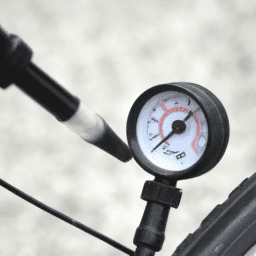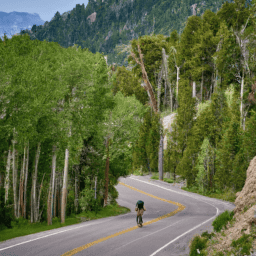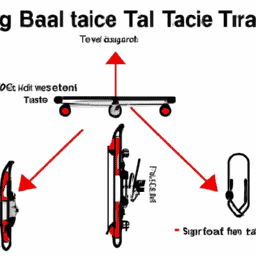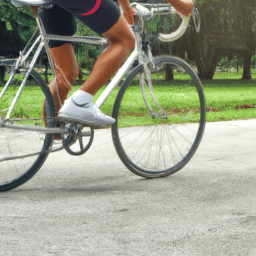Are you new to cycling and curious about the right amount of air for your bike tires? Or perhaps you’re an experienced biker aiming to adjust your tire pressure for the best performance and comfort? Regardless, grasping the elements that influence tire pressure and learning how to identify the ideal pressure is essential for a seamless and secure journey.
In this article, we’ll delve into the technical details of tire pressure, including the impact of tire size, weight, and riding conditions. We’ll also provide step-by-step instructions on how to check and adjust tire pressure, as well as offer tips for a smooth and comfortable ride.
So grab your tire gauge and let’s get started!
Key Takeaways
- The right amount of air pressure for a bicycle tire depends on factors such as temperature, tire type, weight, tire lifespan, and intended use.
- Regularly checking and adjusting tire pressure is necessary for safe and optimal performance, as low pressure increases rolling resistance and reduces speed, while overinflated tires compromise control and decrease traction.
- Different types of tires require different pressure for longevity and safety, and the recommended pressure range can be found in the bike manual.
- Neglecting pressure checks increases the risk of flats, reduced control, and increased rolling resistance, while overinflating can lead to dangerous blowouts and underinflating causes premature wear and tear.
Understand the Factors that Affect Tire Pressure
You’ll want to understand the factors that affect tire pressure before you go pumping up your bike, so you don’t accidentally overinflate or underinflate and end up with a bumpy or sluggish ride.
Temperature effects and tire type both play a big role in determining the right amount of air pressure for your bike. For example, on a hot day, your tire pressure will increase as the air inside the tire expands. On the other hand, in cold weather, the opposite will happen, and your tire pressure will decrease.
The type of tire you have will also impact how much air you need to put in. Different types of tires require different amounts of pressure. For example, road bike tires are typically inflated to a higher pressure than mountain bike tires.
Proper tire pressure is important for both the longevity of your tires and for having a safe and comfortable ride. With these factors in mind, you can now move on to determining the recommended tire pressure for your bike.
Determine the Recommended Tire Pressure
Feeling confident and safe while riding your bike requires knowing the optimal pressure for your tires. Determining the recommended tire pressure for your bike depends on several factors, including the weight of the rider, the type of tire, and the intended use of the bike. Here are four important things to keep in mind when determining the recommended tire pressure:
-
Importance of maintenance: Regularly checking and adjusting tire pressure is essential to ensure optimal performance and safety. Low tire pressure can result in increased rolling resistance, making it harder to pedal and reducing speed. On the other hand, overinflated tires can lead to a harsh ride and decreased traction, compromising control.
-
Consequences of incorrect pressure: Riding with incorrect tire pressure can have serious consequences. It can increase the likelihood of flats, reduce tire lifespan, and compromise handling and control. In addition, it can result in poor performance, making it harder to pedal and increasing the risk of accidents.
-
Consult your bike manual: Refer to your bike manual for the recommended tire pressure range for your specific bike. This will ensure that you’re using the right pressure for your bike and will help you avoid any unnecessary wear and tear.
-
Consider the type of riding: The type of riding you plan to do will also affect the recommended tire pressure. For smooth roads or bike paths, a higher tire pressure is recommended for increased speed and efficiency. On the other hand, for off-road or bumpy terrain, a lower tire pressure is recommended for better traction and a smoother ride.
Now that you know how to determine the recommended tire pressure for your bike, it’s time to get the right tools to ensure proper maintenance and performance.
Get the Right Tools
Having the proper tools is essential for maintaining and optimizing the performance of your bike’s tires. When it comes to proper inflation, you need a reliable tire gauge to accurately measure the tire pressure. A good tire gauge will give you accurate readings and help you avoid over or under-inflation, which can lead to premature tire wear, loss of traction, or even a flat tire.
In addition to a tire gauge, it’s also important to have a tire repair kit on hand in case of emergency. A good tire repair kit should include a patch kit, tire levers, and a portable pump. With these tools, you can quickly repair a punctured tire on the go, ensuring that you don’t get stranded on the side of the road. By having the right tools, you can ensure that your bike’s tires are properly inflated and ready for any ride.
Regularly checking your bike’s tire pressure is an important part of maintaining optimal tire performance. By doing so, you can avoid over or under-inflation, which can lead to a host of issues. To ensure that your bike is always ready for your next ride, make sure to check your tire pressure regularly.
Check Tire Pressure Regularly
It’s crucial to keep tabs on your bike’s tire pressure regularly, as neglecting this simple task can lead to a bumpy ride down the road. Regular maintenance is important to ensuring a smooth and comfortable ride.
Here are a few consequences of neglecting tire pressure checks:
- Increased risk of a flat tire
- Reduced control and handling of the bike
- Increased rolling resistance, making it harder to pedal
Checking tire pressure regularly is an easy task that can prevent these issues. It’s recommended to check tire pressure before every ride, or at least once a week. Simply use a tire pressure gauge to ensure that the tire pressure matches the recommended range listed on the tire sidewall.
Maintaining proper tire pressure is just one aspect of ensuring a smooth and comfortable ride. In addition to checking tire pressure, there are other tips to keep in mind.
Tips for a Smooth and Comfortable Ride
When it comes to achieving a smooth and comfortable ride on your bicycle, there are a few key points to keep in mind.
Firstly, be sure not to overinflate your tires as this can lead to a harsh ride and even damage to your rims.
On the other hand, don’t underinflate your tires either as this can cause sluggish handling and increased rolling resistance.
Finally, consider investing in a suspension system to absorb shocks and bumps on rough terrain, further enhancing your riding experience.
Don’t Overinflate
Make sure you don’t overinflate your bike tire or it may burst, causing potential injury or damage to your bike. Overinflating a tire can lead to a blowout, which can be dangerous if you’re riding at high speeds.
It’s important to know the recommended PSI (pounds per square inch) for your specific tire and to use a reliable pressure gauge to ensure that your tire is not overinflated. Prevent injury and avoid blowouts by checking your tire pressure regularly.
Overinflation can cause the tire to lose traction and increase the risk of accidents. It can also cause premature wear and tear on the tire, leading to the need for more frequent replacements. So, make sure you inflate your tire to the recommended PSI and avoid overinflating.
In the next section, we’ll discuss why it’s equally important to avoid underinflating your tire.
Don’t Underinflate
Don’t make the mistake of underinflating your bicycle tires! While overinflation can lead to a harsh ride and potential blowouts, underinflation can result in even greater problems. It’s important to find the right balance of air pressure to optimize performance and safety.
The consequences of underinflation are numerous and severe. First and foremost, it can cause premature wear and tear on the tire, reducing its lifespan. Additionally, underinflated tires can lead to poor handling and maneuverability, making it difficult to control the bike. This can be especially dangerous when riding at high speeds or on uneven terrain. Moreover, underinflation can increase rolling resistance, making it more difficult to pedal and reducing the overall efficiency of your ride. To avoid these problems, it’s important to regularly check your tire pressure and maintain the recommended level of inflation.
Always carry a tire pressure gauge with you on your rides to check air pressure.
Check your tire pressure before every ride or at least once a week.
Inflate your tires to the recommended pressure level listed on the tire sidewall or in the bike manual.
If you ride on different terrains, adjust your tire pressure accordingly to ensure the best performance.
Considering a suspension system for your bike can also greatly improve your ride quality and comfort. By absorbing shocks and vibrations, a suspension system can help reduce the impact on your body and decrease the risk of injury. But before we dive into that, let’s first make sure your tires are inflated properly.
Consider a Suspension System
Considering a suspension system can greatly improve your ride quality and comfort. It can help you absorb shocks and vibrations on uneven terrains, making your ride smoother and more enjoyable. A good suspension system can also reduce the risk of injury by minimizing the impact on your body.
However, choosing the right suspension system can be challenging. When choosing suspension, you need to consider the type of riding you will be doing and your personal preferences. There are various types of suspension systems available, including front suspension, rear suspension, and full suspension.
Front suspension is ideal for light off-road riding, while rear suspension is suitable for more aggressive off-road riding. Full suspension is ideal for all types of off-road riding and provides maximum comfort. Proper maintenance is also crucial to ensure the longevity and optimal performance of your suspension system.
Regular cleaning and lubrication can help prevent wear and tear, while regular inspections can help detect any issues before they become major problems.
Frequently Asked Questions
Can I use any type of pump to inflate my bicycle tires?
As the saying goes, "the right tool for the job". When inflating your bicycle tires, ensure you have the proper pump with the correct valve attachment. Different types of valves require different pumps. Proper attachment is crucial for an airtight seal.
Is it safe to exceed the recommended tire pressure for my bike?
Exceeding the recommended tire pressure for your bike can result in overinflated dangers such as reduced traction, decreased stability, and increased risk of blowouts. Proper inflation benefits include increased efficiency and comfort.
How often should I check my tire pressure?
Don’t neglect tire pressure, it’s critical for safety and performance. Check it often – monthly at least, weekly if you ride a lot. Temperature affects pressure, so adjust accordingly. Improper pressure can lead to flats or blowouts.
Can I use a tire pressure gauge to measure the pressure in my bicycle tires?
To measure bicycle tire pressure, use a tire pressure gauge designed for bicycles. There are different types available, such as digital and analog. Follow the manufacturer’s instructions for accurate readings.
What should I do if my tire pressure is too low or too high?
If your tire pressure is too low, inflate it to the correct pressure using a gauge. If it’s too high, release air until it reaches the recommended level. Maintaining correct tire pressure is important for optimal performance and safety. Fixing punctures promptly can prevent further damage.
Conclusion
Congratulations! You now know how to properly inflate your bicycle tire for optimal performance and comfort.
Remember, the amount of air you put in your tire depends on various factors such as tire size, weight, and terrain. By determining the recommended tire pressure for your specific bike, you can ensure a smooth and safe ride.
Always use the right tools such as a tire gauge and pump to accurately measure and fill your tire. Check your tire pressure regularly, especially before long rides, to avoid any potential mishaps.
With these tips, you can confidently hit the road and enjoy the ride of your life. So go ahead, pump up those tires like a pro and feel the wind in your hair as you glide down the street like a champ!









